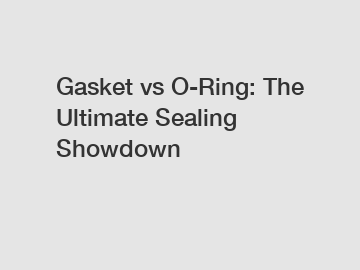Gasket vs O-Ring: The Ultimate Sealing Showdown
Gasket vs O-Ring: The Ultimate Sealing Showdown.
Gaskets and O-rings are two popular sealing solutions used in various industries. Both serve the fundamental purpose of creating airtight or watertight seals between two mating surfaces. However, when it comes to their design, installation, and performance, there are significant differences between gaskets and O-rings. In this article, we will compare these two sealing options, exploring the key characteristics of each, their pros and cons, and their applications, to determine which one emerges as the ultimate sealing solution.
The choice between a gasket and an O-ring primarily depends on the specific sealing requirements of the application and the medium being sealed. Gaskets are typically flat or curbed rubber or metal pieces placed between two surfaces to fill irregularities and create a seal. They are commonly used in static sealing applications where the joint does not move or rotate. On the other hand, O-rings are round, donut-shaped rubber or plastic seals that fit into a groove, creating a seal by compressing between two surfaces. O-rings are primarily used in dynamic sealing applications, where the joint moves or rotates.

The sealing effectiveness of gaskets and O-rings can be attributed to their design and material selection. Gaskets come in various shapes and materials, such as rubber, silicone, metal, or PTFE, allowing them to provide excellent resistance against temperature, pressure, and chemical exposure. Their flexibility helps compensate for the surface imperfections of mating flanges, creating a secure seal. However, gaskets may require additional adhesives or mechanical fasteners to ensure their stability and longevity.
On the other hand, O-rings are typically made of rubber materials, such as nitrile, EPDM, or silicone. Their circular shape provides optimal contact and sealing properties, while their elasticity allows them to adapt to dynamic movements effectively. O-rings offer high resistance against compression set, meaning they maintain their shape and sealing capabilities even under constant pressure. Additionally, O-ring seals are relatively easier to design and install compared to gaskets, making them a preferred choice in many applications.
The choice between gaskets and O-rings has far-reaching implications for various industries. Gaskets find extensive use in applications such as pipeline systems, flanges, and valve connections, where the joints are static and sealing performance is crucial. Meanwhile, O-rings have found widespread usage in hydraulic and pneumatic systems, automotive engines, and appliances, where dynamic movements and flexibility play a vital role in achieving effective sealing.
In conclusion, while both gaskets and O-rings are formidable sealing options, their suitability depends on the specific requirements of the application. Gaskets excel in static sealing applications, offering versatility and durability, while O-rings perform exceptionally well in dynamic sealing environments, providing excellent flexibility and adaptability. By understanding the characteristics and applications of gaskets and O-rings, engineers and technicians can make informed decisions, ensuring the optimal sealing solution is chosen for any given scenario.
Are you interested in learning more about rubber oil seals manufacturer, King Seal, wholesale fkm tc oil seal? Contact us today to secure an expert consultation!


